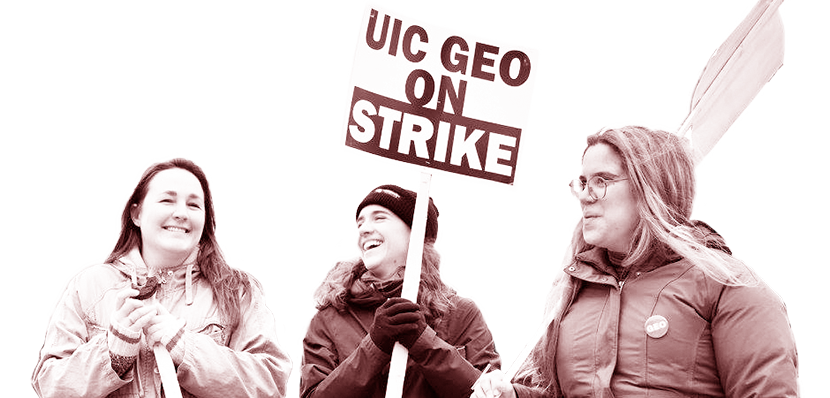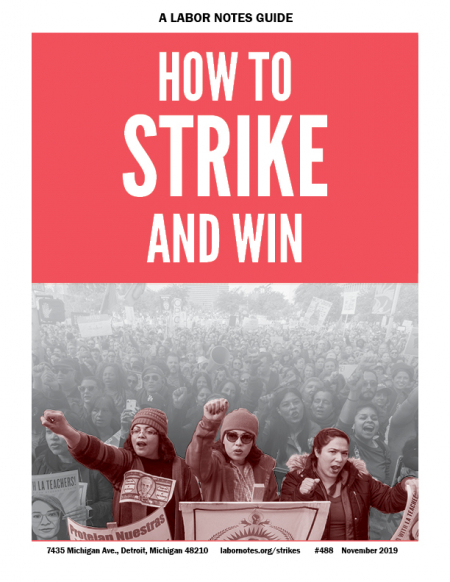Pushing from Below

A rank-and-file contract campaign can become a springboard to union reform. Photo: UIC GEO.
Rank and filers can organize from the bottom up to put on a contract campaign and strengthen a strike.
How to Strike and Win
A Labor Notes Guide
labornotes.org/strikes
The Big Picture
Know Your ABC's
Building Blocks
- Turn Up the Heat
- Organize the Organized
- Democracy: Who Owns the Strike?
- Community: Who Else Owns It?
- How to End a Strike
At a Glance
A strike is a powerful tool if you’re looking to transform your union into one that pays attention to members’ needs and wants. A rank-and-file contract campaign can become a springboard to union reform.
So the advice in this booklet is not just for union officers. The same principles apply if you’re a group of members who decide to plan a more militant contract fight, with or without your officers’ support. But you’ll face extra hurdles.
Too many leaders are unwilling to use all the power at the union’s disposal, or they’re stuck in routine ways of dealing with management and members. Ultimately the power of the rank and file is to organize, themselves, a strike that can win despite lack of leadership; to vote no on a bad deal; and to make incumbents fear the next election.
Here are some ways that union activists can get things moving from the ground up. Some are from contract campaigns, not strikes. Consider where you're starting from and what's realistic in your union.
ORGANIZE A SURVEY
In the union of graduate employees at the University of Illinois at Chicago, more than half the members are international students.
Contract talks had been bogged down for months when 15 of these members attended a negotiating session and delivered emotional testimonies about their difficulties paying rent, getting health insurance, making ends meet without access to second jobs or public benefits, and paying steep fees back to the university.
Management was unmoved. But after testifying, the 15 decided to form an International Caucus and involve more workers like themselves in the contract campaign.
They organized a survey of international grad employees’ working and living conditions, which were dire. The results undermined a similar survey from management, which had attempted to show that workers’ living conditions were tolerable.
This grassroots effort jump-started the contract campaign, escalating to a threeweek strike where the union won relief from fees and a big wage increase. Afterwards, some of the newly involved international workers became shop stewards.
For more on contract surveys, see here.
ORGANIZE A CONTRACT ACTION TEAM
Santa Cruz County workers formed a Fair Wage Action Team (FWAT) in 1999 because they were dissatisfied with their previous contract. This group started the organizing that led to a 2002 strike.
“We started meeting in our homes and kitchens,” said Kat Shelton, a worker in homeless services, “getting facts, getting proof we were underpaid, forming committees, and looking for leaders who would go the limit.”
Over the next two years, FWAT folks were elected as chapter and local union presidents. They developed a memberrun email bulletin called “@@ Union Eyes” to get out their view of the issues and tie together their diverse workforce. When it came time to elect a negotiating committee in 2002, FWAT activists were careful to leave key leaders like Shelton off the committee, free to lead field action while negotiators were tied up in bargaining.
Shelton would become “Momma CAT,” coordinator of a Contract Action Team that started as a phone tree, punctuated negotiations with mobilizations, and eventually became a picket and field action structure.
At the height of the strike her team would include 25 “top CATS” coordinating 170 CATs, or worksite leaders, able to get the word out to over 1,800 people in less than two hours.
They won the highest raises of any comparable group of workers in the state, while reaping a harvest of new union activists.
For more on CATs, see here.
PUSH A POPULAR DEMAND

SUPPORT LABOR NOTES
BECOME A MONTHLY DONOR
Give $10 a month or more and get our "Fight the Boss, Build the Union" T-shirt.
New York City teachers’ bargaining in 2018 coincided with a new state law that guaranteed paid family leave for most private employees. Meanwhile even teachers who had just given birth were getting zero paid leave.
Incensed, teacher Emily James started an online petition addressed to the mayor and the union president, demanding paid maternity leave for teachers: “These are women who devote their lives to helping raise other people’s children.” The petition went viral, racking up 80,000 signatures.
As the petition gathered steam, a reform caucus in the union, the Movement of Rank-and-file Educators, organized forums, marches, and walk-ins, pushing leaders to take up the issue.
When these union leaders saw a parade, they wanted to get in front of it. You know your grassroots group is winning when the officers start claiming your issue was their idea all along. Parental leave wouldn’t have happened without the grassroots effort.
ORGANIZE A SICKOUT OR A WILDCAT STRIKE
Detroit teachers organized a slew of rolling sickouts in 2015-2016 drawing attention to falling ceiling tiles, water damage, broken equipment, mice-infested classrooms, pay cuts, rising health care costs, inflated work hours, loss of prep time, administrative bullying, abusive evaluations, and the district’s failure to bargain with the union while it sunk money into a consulting firm.
At first teachers started organizing the actions in just a small number of schools. Then the school district’s executive declared the actions “unethical”—sparking much greater interest. Four hundred indignant leaders joined a conference call. By forwarding text messages, the teachers organized a day of action that shut down 88 out of 97 schools.
When the district tried to stiff teachers on their salaries a few months later, another mass sickout closed even more schools and attracted national press coverage. By this time the union leaders were on board, and the teachers won on the pay issue.
In Oshawa, Ontario, last winter, auto workers angry at General Motors’ plan to close their plant pulled off a sit-down strike without authorization from their union, Unifor.
Unifor had been holding milder actions to protest the closure—small rallies, lawn signs, and a media campaign. For the workers, the last straw was the day they gathered at work to watch a televised press conference where they hoped GM would back off its threat. Instead, GM doubled down.
So the truck-production shift sat down. Workers gathered together, refusing management’s pleas to go back to work. Management then told everyone to leave, but they refused that too.
It took hours for the union’s plant chair to drive to the factory. Eventually he arrived, gave a speech, and led workers out of the plant. Meanwhile GM had lost a shift’s worth of work. And Unifor leaders got the message that members wanted a more militant plan of action.
But be careful! These tactics are high-risk. See here.
DEMAND A DEMOCRATIC VOTE
Seven days into the 2012 Chicago teachers strike, leaders brought a tentative agreement to the union’s House of Delegates and recommended ending the walkout. But delegates balked. This was a strike owned by the members, they reasoned, so members should get a chance to weigh in on whether the deal was enough—before dissipating their power by returning to work.
The delegates voted to extend the strike two more days. Copies of the entire tentative deal were distributed around the city. Instead of walking picket lines, teachers sat in circles on the sidewalks, debating it.
Informed by these discussions, the delegates reconvened and voted overwhelmingly to suspend the strike. Two weeks later, members voted by 79 percent to ratify it. And CTU probably set a record for the percentage of a union’s membership that has thoroughly read and understood its whole contract.
ORGANIZE FOR A ‘NO’ VOTE
Finally, when it comes time to vote on a proposal, rank and filers can take matters into their own hands and force negotiators back to the table.
Forty thousand auto workers at Chrysler, organizing by word of mouth and through Facebook groups, voted no 2-1 in 2015 on a tentative agreement that would have extended the two-tier pay system. They printed up protest T-shirts, rallied, and shared photos of their local leaflets and vote-no tallies, as momentum built for a big “no.”
Their bargainers went back to the table and negotiated an improved deal.
UPS Teamsters organized a grassroots national campaign to vote no on their tentative agreement in 2013. The master contract was narrowly approved, but regional supplements and riders affecting 63 percent of workers were rejected—forcing Teamster leaders to return to the table for the whole enchilada and improve the health care benefits.
Still mad that the deal did little on top concerns—forced overtime for drivers, low pay for package sorters, and harassment and surveillance for everyone— members in a few regions held out, voting no two and three times until officers overruled them.
Fury over that outcome propelled an electoral challenge that nearly toppled the Teamsters’ top officers in 2016. The vote-no movement was even bigger for the next contract, in 2018, when UPSers voted down a master contract that would create a new lower-paid tier of drivers. Union officers imposed the deal anyway. It remains to be seen whether the resulting anger is enough to carry reformers to victory in the union’s 2021 election.
As this story from the Teamsters shows, changing your union from the ground up is a marathon, not a sprint. Think of your contract campaign as one battle in a longer-term campaign to build members’ power.





